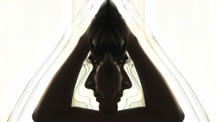Gunilla Josephson is known as one of Canadas most innovative and challenging video artists. This time she collaborates with celebrated musician Eve Egoyan in an enigmatic and powerful film portrait. E.V.E Absolute Matrix was filmed with High Definition clarity, in claustrophobic close-up over a five-hour period, during which Egoyan performed a marathon piano composition. GJ has then distilled and manipulated the footage into images of cinematic proportions. Eve Egoyans face becomes a portrait that is part emotionally intense document and part iconic monument. The result is a work of exquisite beauty that pushes the boundaries of both art and cinema.
‘A pianist and a camera make music of the id’
GARY MICHAEL DAULT April 25, 2009
mail@garymichaeldault.com
http://gunillajosephson.com/videowork/eve-absolute-matrix/
2009, 48:00
E.V.E Absolute Matrix is constructed from 86.400 carefully chosen and manipulated video frames from the 5 hour video footage of a studio performance with Toronto musician Eve Egoyan playing Inner Cities, a contemporary 5 hour epic for solo piano by composer Alvin Curran. In this video we see a woman’s head/face persistently and over an extended period of time betraying a multitude of shifting facial expressions slowly moving into an inward mirror image of itself.
View E.V.E: Absolute Matrix (Excerpts) in HD on YouTube
E.V.E. Absolute Matrix by Gunilla Josephson at Trinity Square Video showed at Trinity Square Video, 401 Toronto.
Swedish-born, Toronto-based video artist Gunilla Josephson has worked with pianist Eve Egoyan before, notably in the generation of soundtracks for Josephson’s Venus Hedda: A Video and Audio Installation (2001), Happy House: The Id, the Kid and the Little Red Fireman (2001) and The Blood-Red Heart of Johanna Darke (2005). But never until this new work, E.V.E. Absolute Matrix, has the fusing of their sensibilities, their presences as artists, been so fully and so startlingly realized. E.V.E. is a 60-minute looping video installation.
It is now showing at Toronto’s Trinity Square Video, as part of the city’s Images Festival. During the first half of it, more or less, you see Egoyan in extreme close-up, balletically bobbing and weaving before something or other – presumably her piano – as she brings her characteristic intensity to the performance of what Josephson says was actually a five-hour work for piano called Inner Cities by composer Alvin Curran, mounted in the autumn of 2007 at Toronto’s Glenn Gould Theatre. Positioned before a fall of filmy white curtains – which, given Josephson’s virtuoso wielding of High Definition video technology, seem as sweetly diaphanous as clouds and as touchable as sugar – Egoyan’s face, with her darkling complexion and her mahogany-dark hair, becomes a kind of conduit to the idea of pure, absolute expressiveness. The music that accompanies Egoyan’s sublime agon is not any longer Curran’s, of course, but, rather, a strange, protracted, multilayered extrapolation from that music, a sort of bee-like rushing that flows throughout the video-hour like the progress of time itself. And all through this otherworldly screen-time, Egoyan’s fabulous face seems to register a whole encyclopedia of emotional states – as if she were the solitary exemplar of everything human emotion can be.
Josephson says she came to the idea of E.V.E. by watching Egoyan in the five-hour performance in 2007, noting that from her position in the hall, she could see only Egoyan’s face, floating above the piano. It led her to the idea of somehow capturing all of the modulations of what she calls “the extremes of de-contextualized emotional states.” Josephson points out that the film is all close-up, and is emphatically without “the usual tropes of cinema” (zooms, cuts, pans, etc.). There is, in other words, no escaping (as in escapism) the focused intensities of E.V.E. (how fortunate Josephson was that Egoyan’s name wasn’t something like Susan or Wendy – something that lacked archetypal resonance).
It is important to add, at this point, that E.V.E. is not simply a protracted close-up portrait of an artist in the throes of and in thrall to her work. Rather, Josephson has employed the already compelling Egoyan as the sort of raw stuff of endless transformation. It’s not always easy to tell, but Josephson has continually modified Egoyan’s face and body (of which only her bare shoulders are visible) in the course of the work. If you pay a little peripheral attention to the entire Eve image – wrenching yourself away momentarily from Egoyan’s face – you will notice that subtly odd things happen: Her shoulders sometimes grow a little smaller, her face darkens, her movements slow imperceptibly (“the entire video is slowed by about 35 per cent,” Josephson tells me, as we sit watching the piece together). But in the course of the work, E.V.E. becomes considerably more disturbing than the oddness these delicate distortions cause. Gradually, and then all during the second half, Josephson transports Egoyan from performer to a soft series of emblematic shapes that gnaw at the very essence of the birth of expression, at the wellsprings of art.
By changing Egoyan into a kind of Rorschach-like series of terrible, severe symmetries, the pianist becomes a feral creature – a spidery miasma of expressive urgencies so extreme she seems to modulate into a dark, vulvic organ – throbbing with the agonies of generation. Astounding.

